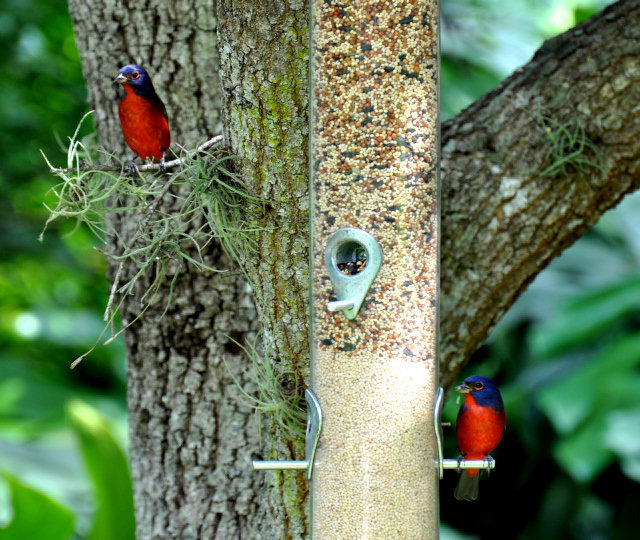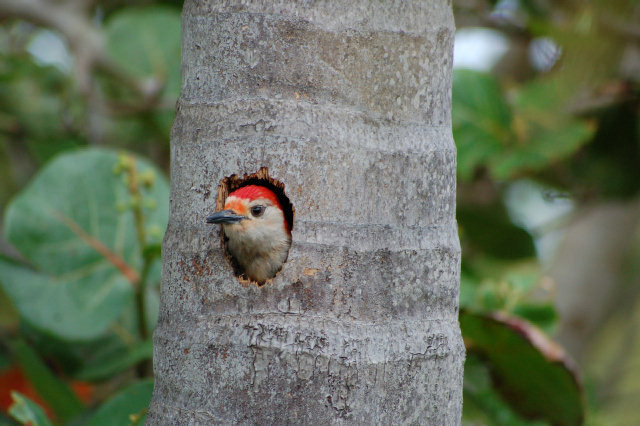Make your backyard a wildlife habitat

As published in the Miami Herald
Imagine sitting in your backyard as colorful birds chirp and flit about and bountiful butterflies scout blooms for nectar. With the right plan and the right plants, you can make your backyard into a wildlife habitat that will attract amazing birds and beautiful butterflies.
Birds like berries and insects, so choose a variety of plants that will both produce berries and be home to small insects that birds like to eat. Native plants are always a good choice — and make sure you have plenty of small shrubs for the birds to go in and out of while they are hunting and gathering. Good shrubs include any of the stoppers (white, Spanish, red, red berry, Simpson’s), wild coffee and Bahama coffee, as well as bitter bush and wild sage.
 |
| Painted Buntings like seed mixes containing white millet. |
Larger trees are also very important, as many birds like to hunt insects in oaks, gumbo limbos, sea grapes and native tamarinds. In my yard, I see more birds in the larger trees, where they are easier to spot, than I do in the shrubs.
A special mention goes to the wonderful wildlife-attracting qualities of the native firebush, Hamelia patens. It draws mockingbirds and catbirds to its tiny berries and hummingbirds and several species of butterflies to its flowers. In the winter, it is awash in activity as birds and butterflies fly in and out of it to feed and frolic. Plant several firebush in your yard in a spot where you can easily view the wildlife activity.
If you want hummingbirds, the firebush is a good place to start. You can add to your chances of attracting these tiny speed merchants by planting the Chinese hat plant, Holmskioldia sanguinea, and the Bahama swamp bush, Pavonia bahamensis. If you have all three of these plants, you are almost guaranteed to attract hummingbirds.
 |
| Leaving palms in your yard after they die can result in a new home for a Red Bellied Woodpecker. |
Hummingbirds are seasonal. They arrive in October and stay for the winter. Plant your hummingbird plants in the full sun so they can bloom at their best. You should also place your plants where you can see the hummingbird activity from your deck or a picture window. And don’t waste your time with hummingbird feeders — they will not work as well as the proper plants.
Bird feeders are optional in your yard as they often attract the most common birds and lazy squirrels, but there is one species of bird that makes feeders especially worthwhile: the Painted Bunting, which visits South Florida in the winter. It is a tiny, multi-colored bird — the mature male is a striking blue, red and green. Immature Painted Buntings of either sex are green.
The Painted Bunting loves to visit feeders that contain white millet. Pure white millet works better than feed mixes with millet added since squirrels are less inclined to feed on pure millet. Use a feeder that has very small perches and holes for feeding, otherwise you will be overrun by Mourning Doves and Grackles. Put the feeder near shrub cover that the buntings can go in and out of as they feed. They like to hide just before they feed.
A water feature is a must for attracting wildlife. You can get as elaborate as a pond with a series of waterfalls or as simple as a birdbath, but whatever you do, make sure that the water is fresh and doesn’t go stagnant. A pond with a waterfall would keep the water fresh, but if you have a birdbath, try to change the water each day.
 |
| Hummingbirds will find your yard if you have the right plants. |
ENTICING BUTTERFLIES
Many of the plants listed above will attract butterflies, and simply by having a varied yard with many plant choices, you will be able to attract a multitude of species. But it’s important to refrain from pesticide use. You will never attract butterflies to your garden if you constantly spray pesticides. Even if you are trying to kill whiteflies or scale, you will end up doing damage to the butterfly population. Pesticides will also harm the tiny insects that many birds feed on.
No matter what size your yard is, you can add some of the plants and hardscape features listed here and turn your backyard into a bird and butterfly paradise. Get started today on a list of plants you would like to add, and it won’t be long before the birds and butterflies beat a path to your backyard.
Jeff Wasielewski is an outreach specialist at Fairchild, an expert in South Florida horticulture and a professor of horticulture at Miami Dade College. He can be reached at jeffw@fairchildgarden.org.
